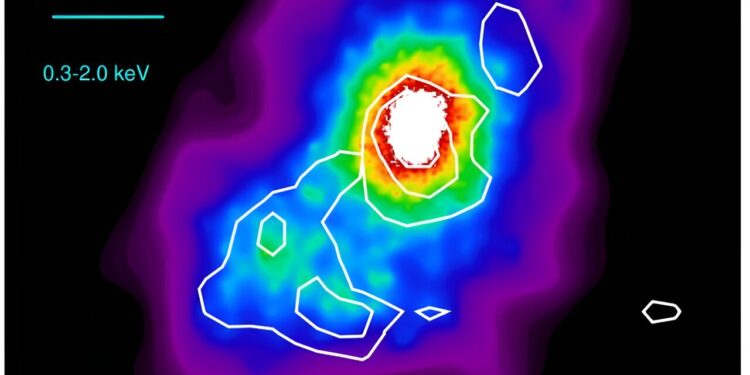Chandra ACIS-S image showing the nuclear region of NGC 5252 in the soft X-ray band (0.3–2.0 keV). The image is superimposed with the emission contours (OIII) of the HST image subtracted from the continuum. Credit: arXiv (2024). DOI: 10.48550/arxiv.2401.09172
The nearby lenticular galaxy NGC 5252 hosts extremely extended cones of ionized matter. Recent observations by an international team of astronomers have inspected these remarkable structures, providing important information about their properties. The results of the observation campaign were published on January 17 on the pre-print server arXiv.
Ionization cones are cones of ionized material extending from active galactic nuclei (AGN). They reach sizes of several tens of thousands of light years and are observed mainly in Seyfert type II galaxies. Studying these structures could help us better understand the interactions between AGN and their host galaxies.
One of the largest ionization cones in the local universe is found in NGC 5252, a Seyfert type 1.9 galaxy, at a distance of about 329 million light years. Previous observations of NGC 5252’s ionization cones revealed that they span more than 130,000 light years and are composed of several arcs confined in a bi-cone encircling the galaxy’s core.
Recently, a group of astronomers led by Chen Wang of Xiamen University in China took a closer look at these cones and studied them with X-rays. To this end, they used the Chandra X-ray Observatory of the NASA.
“With a total exposure time of 230 ks, the full dataset of Chandra observations used in this work is almost four times deeper than the previous one, allowing us to study the spatially resolved properties of the emission extended over a large radial distance from the nucleus,” explained the researchers.
Observations by Wang’s team detected the outermost X-ray arc of the cones extending out to about 65,000 light-years from the core of NGC 5252. In general, the the cone structures mainly follow the direction of optical radiation. ionization cones in the southeast and northwest directions.
The Chandra data suggest that the observed extended soft increases, the photoionization parameter of the ionized gas in the core subcones remains constant or decreases slightly.
Chandra observations also show that the inferred luminosity of NGC 5252’s core was once much higher than its current luminosity. Astronomers estimate that it may have shrunk by around 98% over the past 64,000 years. They speculate that a minor merger event could have caused such a change in brightness.
Based on the collected data, the authors of the paper conclude that NGC 5252 resembles a relic quasar with a supermassive black hole (SMBH) as massive as a billion suns. They assume that the galaxy underwent a minor merger and transitioned to a state of low accretion rate.
More information:
Chen Wang et al, Deep Chandra observation of the remarkable ionization cones of NGC 5252, arXiv (2024). DOI: 10.48550/arxiv.2401.09172
Journal information:
arXiv
© 2024 Science X Network
Quote: A study explores the spectacular ionization cones of the galaxy NGC 5252 (January 25, 2024) retrieved on January 25, 2024 from
This document is subject to copyright. Apart from fair use for private study or research purposes, no part may be reproduced without written permission. The content is provided for information only.



